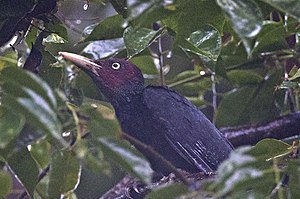Philippine Woodpecker
| Philippine Woodpecker | ||||||||||
|---|---|---|---|---|---|---|---|---|---|---|

Philippine woodpecker ( Mulleripicus funebris ) |
||||||||||
| Systematics | ||||||||||
|
||||||||||
| Scientific name | ||||||||||
| Mulleripicus funebris | ||||||||||
| ( Valenciennes , 1826) |
The Philippines Woodpecker ( mulleripicus funebris ) is a species of bird from the family of woodpeckers (Picidae). This medium-sized woodpecker species is endemic to the Philippines and inhabits forests of almost every species. Very little is known about its way of life. The species is not very common, locally quite common, the population is apparently stable. The Philippine woodpecker is therefore classified by the IUCN as ![]() (= least concern - not endangered).
(= least concern - not endangered).
description
Philippine woodpeckers are medium-sized and almost monochrome black woodpeckers with a remarkably long and thin neck, a rather small head and a long and stiff tail that is slightly bent forward towards the tip. The beak is quite long, almost pointed and narrow at the base, the ridge of the beak is bent downwards. The body length is about 30 cm, the weight 139-183 g; the species is thus somewhat smaller, but significantly lighter than a green woodpecker .
The species shows a clear sexual dimorphism in terms of coloration . Males of the nominate form are solid black apart from the head and neck. The entire upper surface including the upper wings and tail shows a bluish sheen. The underside is a little lighter, slate black and without gloss, occasionally there are a few fine light spots on the chest. The forehead, top of the head, beard, cheeks and the front ear covers are dark red, with at least some black feather bases visible. The rest of the head and neck are finely dotted with white on a black background, the throat sometimes also on a more gray background; these points can sometimes be missing.
The beak is blackish, the middle and base of the beak and the lower beak are bright yellowish horn-colored. Legs and toes are brownish gray. The iris is light yellow.
Females are missing the red areas on the head, these areas are black and also finely dotted with light, although the light dots are occasionally missing in females.
Vocalizations
Many observers have noted calls, but these have not yet been described in detail. There is also no information about whether the species drums.
distribution and habitat
This species of woodpecker is endemic to the Philippines . Luzon , the Polillo Archipelago , Catanduanes and Marinduque in the north and east and Samar , Leyte and Mindanao in the south of the archipelago are populated . The size of the total distribution area is not known. Filipino woodpeckers inhabit forests of almost every type, from evergreen tropical forests to montane pine and oak forests, and can also be observed in the vicinity of cultivated land. Only heavily mossy forest types are avoided . The height distribution extends from the lowlands to 1350 m.
Systematics
The number of subspecies is controversial, today only two are usually recognized:
- Mulleripicus funebris funebris (Valenciennes, 1826) ; the nominate form inhabits Luzon, Catanduanes, Marinduque and the Polillo Islands in the north of the Philippines.
- Mulleripicus funebris fuliginosus Tweeddale , 1877 ; South of the Philippines with Samar, Leyte and Mindanao. Shorter tail and shorter and higher beak than nominate shape, overall lighter and red head parts in the male less extensive. The upper side including the upper wing and tail is more slate black than black, the underside is grayer. The red color on the head of the male is limited to a broad stripe of beard, the rest of the head is also gray in both sexes. The beak is light yellowish-ivory in color with a darker base.
Two other subspecies ( M. f. Mayri in northern Luzon and M. f. Parkesi on the Polillo Islands) are reported by Winkler et al. still recognized, but described as hardly differentiated from the nominate form. Today they are mostly assigned to the nominate form.
Way of life
There is hardly any information on the way of life so far. The species is apparently largely bound to the upper tree layer and has so far been observed in large living, half-dead and dead trees at a height of over 20 m. So far nothing is known about food. Philippine woodpeckers are found singly or in pairs. The breeding season on Luzon and the Polillo Islands probably extends from March to May, on Samar and Leyte from April to August. Further information on the breeding biology is not yet available.
Existence and endangerment
There is no information on the size of the population. The species is not very common, locally quite common, the population is apparently stable. The Philippine woodpecker is therefore classified by the IUCN as safe (“least concern”).
swell
Individual evidence
- ^ BirdLife International (2010) Species factsheet: Mulleripicus funebris . ( Online , accessed September 15, 2010)
- ↑ a b The Philippine Woodpecker on Avibase ( online , accessed September 15, 2010)
- ↑ Hans Winkler, David Christie and David Nurney: Woodpeckers. A Guide to the Woodpeckers, Piculets, and Wrynecks of the World. Pica Press, Robertsbridge 1995: p. 392
literature
- Hans Winkler , David Christie and David Nurney: Woodpeckers. A Guide to the Woodpeckers, Piculets, and Wrynecks of the World. Pica Press, Robertsbridge 1995, ISBN 0-395-72043-5 , pp. 164-165 and 391-392.
Web links
- Mulleripicus funebris in the endangered Red List species the IUCN 2009. Posted by: BirdLife International, 2009. Retrieved on 15 September, 2010.
Other web links
- Videos, photos and sound recordings for Mulleripicus funebris in the Internet Bird Collection